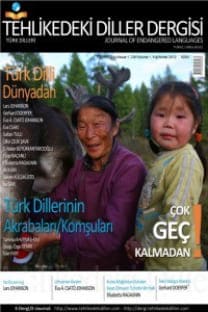Kültürel Bilişi Oluşturmada Deyimlerin Rolü: Çuvaşça ve Türkçe Örneği
İletişimin temel taşı olarak nitelendirilen dil olgusu nesilden nesile aktarılan, kültürel ve devingen bir yapıdır, ancak bu yapı zamanla konuşucusunun kalmaması, diğer kuşaklara aktarılmaması ya da başkaca diller tarafından baskılanması gibi nedenlerle yok olmakta ve zaman içerisinde ölmektedir. Bu yok oluşu tanımlayan tehlikedeki dil(ler) (endangered languages) kavramı belli sınıflandırmalar temelinde dillerin yok oluş derecelerini, nedenlerini ve alınabilecek önlemleri ele almaktadır. Dünyanın birçok yerinde konuşulan birçok dil günümüzde bu yok olma tehlikesi ile karşı karşıyadır. Bu dillerden biri olan ve Türk dil ailesinin en eskicil özelliklerini taşıyan Çuvaşça da tehlikedeki Türk dillerindendir. Bu çalışma Çuvaşça ve Türkçede biri göz sözcüğü olan deyimlerin temsil ettiği düşünce içerikleri olan kavramların etiketlenerek karşılaştırılmasını ve aradaki benzerliklerin bu iki dil arasında ortak bir kültürel biliş sergileyip sergilemediğini saptamayı amaçlamaktadır. Çalışmada Çuvaşçada göz sözcüğü ile kurulmuş 83 adet deyim listelenmiş, bu deyimlerde 22 kavram etiketlenmiştir. Türkçede kurucularından biri göz sözcüğü olan toplam 175 deyim listelenmiş ve bu deyimler 29 kavram ile etiketlenmiştir. Elde edilen bulgular her iki dilde de en sık etiketlenen kavramların ortak olduğunu göstermektedir, ancak bu bulguların kavramlar temelinde ortak bir kültürel biliş sunmadığı gözlemlenmiştir.
Anahtar Kelimeler:
Çuvaşça, Türkçe, deyim, kavram, kültürel biliş
The Role of Idioms in Forming Cultural Cognition: The Case of Chuvash and Turkish
The language phenomenon, which is described as the cornerstone of communication, is a cultural and dynamic structure that is transferred from generation to generation, but this structure disappears and dies over time due to the lack of speakers, not being transferred to other generations or suppressed by other languages. The concept of endangered languages defines this extinction and deals with the degree of extinction of languages, its causes and measures on the basis of certain classifications. Many languages spoken in many parts of the world are in danger of extinction today. One of these languages, Chuvash, which has the most archaic features of the Turkish language family, is also an endangered Turkic language. This study aims to label the concepts represented by the idioms in Chuvash and Turkish in which one of the constituents is the word göz, and to compare them with the concepts represented by the idioms, and to determine whether the similarities between these two languages suggest a common cultural cognition. In the study, 83 idioms constituted with the word göz in Chuvash were listed, and these
idioms were labeled with 22 concepts. A total of 175 idioms with göz as one of the constituents were listed in Turkish and these idioms were labeled with 29 concepts. The findings indicate the most frequently labeled concepts in both languages are common, but it has been observed that these findings do not present a common cultural cognition on the basis of the concepts.
Keywords:
Chuvash, Turkish, idiom, concept, cultural cognition,
___
- Atik, K. (2021). “The Tatar community and Tatar language education in Australia”. Journal of Endangered Languages. 19/11, p. 309-319.
- Braun, A. (2012). “Language maintenance in trilingual families: A focus on grandparents”. International Journal of Multilingualism. 9/4, p. 423-436.
- Bunis, D. M. (2011). “The Jewish language of the Ottoman Sephardim”. European Judaism: A Journal for the New Europe. 44/1, p. 22-35.
- Demircan, Ömer. (1988) Dünden Bugüne Türkiye’de Yabancı Dil: Arapça, Farsça, Fransızca, İngilizce, Almanca, Latince, İtalyanca Dillerinin Öğretimi ve Türkçe’nin bu Diller karşısındaki Durumu. İstanbul: Remzi Kitabevi.
- Giles, Howard, Bourhis, Richard Y. and Taylor, Donald (1977). “Towards a theory of language in ethnic group relations”, Howard Giles (Ed.). Language, ethnicity and intergroup relations. London: Academic Press, p. 307-348.
- Grinevald Craig, Colette (1997). “Language contact and language degeneration”, Florian Coulmas (Ed.). The handbook of sociolinguistics. Oxford: Blackwell, p. 257-270.
- Jamai, Abdeslam (2008). Language use and maintenance among the Moroccan minority in Britain. Ph.D. Dissertation. European Studies Research Institute (ESRI) of University of Salford.
- Ostler, Nicholas (2011). “Language maintenance, shift, and endangerment”, Rajend Mesthrie (Ed.). The Cambridge handbook of sociolinguistics. Cambridge: Cambridge University Press.
- Özfidan, Burhan, Burlbaw, Lynn. M. and Aydın, Hasan (2018). “The minority languages dilemmasin Turkey: A critical approach to an emerging literature”. Journal of Educational Issues. 4/1, p. 1-19.
- UNESCO (2003). “Language vitality and endangerment”. https://unesdoc.unesco.org/ark:/ 48223/pf0000183699 (Date of retrieval: May 15, 2022).
- UNESCO (2011). “Atlas of the world’s languages in danger”. https://unesdoc.unesco. org/ark:/48223/pf0000192416 (Date of retrieval: May 15, 2022).
- UNESCO (2017). “Interactive atlas of the world’s languages in danger”. http://www.unesco. org/languages-atlas/index.php (Date of retrieval: May 17, 2022).
- Ünver-Lischewski, Nevra (2018). “Planning the languages of Turkey”, Peter A. Mumm (Ed.). Sprachen, Völker und Phantome: Sprach- und kulturwissenschaftliche Studien zur Ethnizität, Berlin. Boston: De Gruyter, p. 245-263.
- Zhang, Donghui. (2008) Between two generations language maintenance and acculturation among Chinese immigrant families. El Paso: LFB Scholarly Publishing LLC.
- Başlangıç: 2012
- Yayıncı: Ülkü ÇELİK ŞAVK
